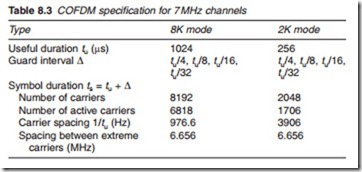Coded OFDM
Besides multipath interference, terrestrial transmission suffers from frequency-dependent noise caused by narrowband interfering signals within the bandwidth. This is why it is necessary to use a more powerful FEC coding system, the C in COFDM, than that used in satellite broadcasting. Noise in the transmission media often causes bits to lose their original logic levels, rather like the erasures introduced by puncturing. At the receiving end, soft decision decoding has to establish whether a received bit is actually logic 1 or logic 0 before an irrevocable decision (hard decision) is taken on its integrity. The process involves gathering information about the effect of noise on all the carriers in the multiplex. A history of possible sequences and their relative likelihood is thus established. Combined with the FEC punctured codes, this history of sequences and their likelihood, known as channel state information (CSI) ensures that errors caused by frequency-selective interference and fading are detected and corrected at the receiving end.
8K/2K COFDM modes
For DTTV, the European DVB system is based on COFDM modulation with either 8K (8192) or 2K (2048) carriers with a symbol duration tu of 896 and 224 f.s, respectively. The effective number of carriers, i.e. the actual number of carriers that may be used for COFDM modulation, is 6817 (8K mode) and 1705 (2K mode). The remaining 343 carriers (2K mode) or 1375 carriers (8K mode) are transmitted without any modulation during the guard period. Apart from removing the effect of reflected signals, the guard interval performs two other important functions: (a) the carriers that are transmitted during the guard interval are used by the decoder for synchronisation purposes and (b) the guard period allows the useful carriers to settle following the abrupt changes in their phases each time they are modulated by a new set of symbol bits. From among the 1705 carriers (2K system), 1512 are used to carry data. The remaining carriers are used to carry the necessary reference signals for accurate decoding to take place at the receiving end. The 2K COFDM mode is currently used in the UK.
However, DTTV being a very flexible broadcasting system, the 8K mode may be introduced in the future without making current decoder boxes redundant. Table 8.2 lists the main characteristics of an OFDM signal for a channel with 8 MHz bandwidth.
The 2K mode provides optimum performance for mobile receivers whereas the 8K mode is generally preferable for large-scale SFNs. The sys- tem may be adapted for other channel bandwidths by merely changing the ratio tu/n; where n is 2048 for the 2K mode and 8192 for the 8K mode. This ratio is known as the elementary time element, T, and 1/T is known as the OFDM system clock. By changing T, hence 1/T, the characteristics of the emitted signal (apart from the bandwidth) is maintained. For the 8 MHz, T = 224/2048 and 1/T = 2048/224 = 64/7 or 9.143 MHz. The same figure is obtained for the 8K mode namely 8192/896 = 9.143. For the 7 MHz channel, 1/T = 2048/256 = 8 MHz. In a 7-MHz channel, the carrier spacing is 976.6 Hz (8K mode) and 3906 Hz (2K mode). Table 8.3 lists OFDM specifications for channels with 7 MHz bandwidth used in some countries including Australia.
The actual bit rate available depends on the type of modulation of the carriers. 64-QAM would result in a 27 Mbps multiplex whereas 16-QAM would almost halve the bit rate capacity. However, 64-QAM is more error- prone than 16-QAM. QPSK must be used for DTTV reception on fast- moving vehicles, e.g. trains and cars; this reduces the bit rate capacity to 10–12 Mbps but it also reduces the possibility of decoding errors. In the UK, the introduction of DTTV was notorious for picture freeze and pixelisation.
This was mainly as a result of the commercial services using 64-QAM to pack as many programmes as possible within a single multiplex. That bad reputation was only broken with Freeview which changed to 16-QAM.

